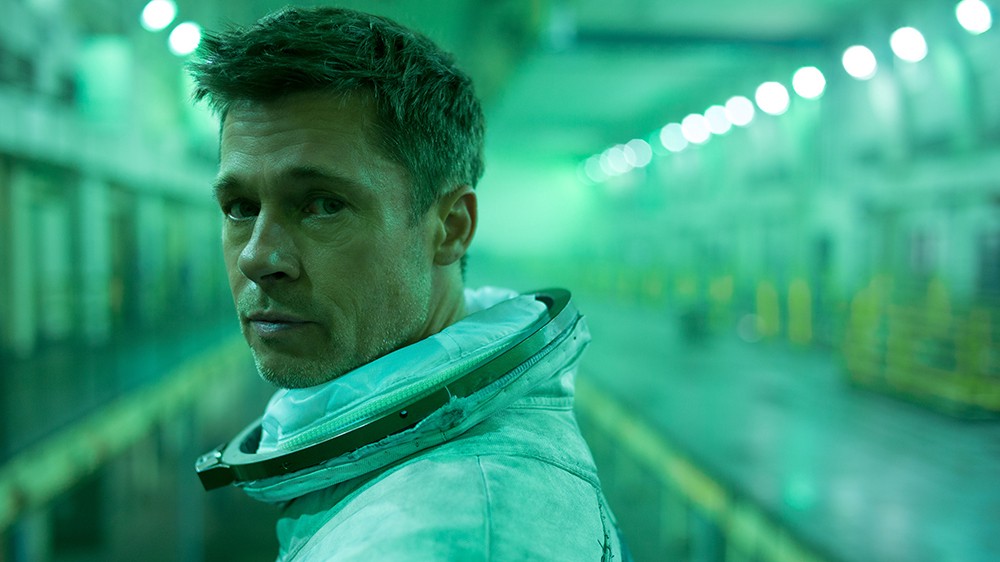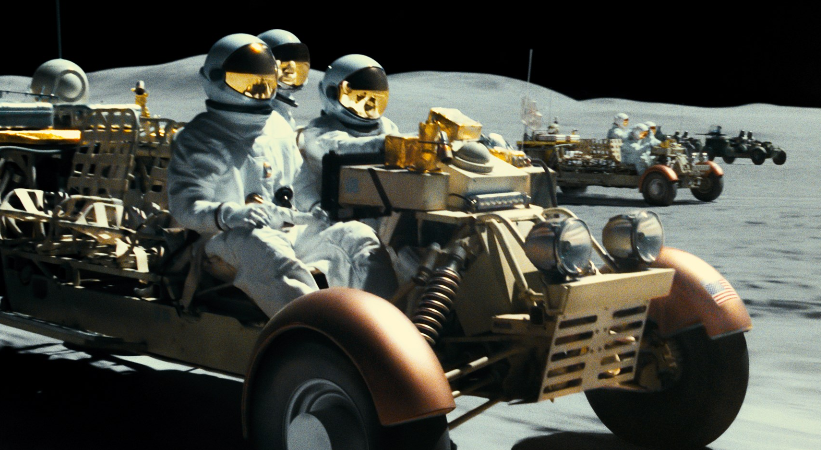Incluvie Film Festival Review of 'Sleep No More'
This short film was an overall creative success.
“Ad Astra” follows Roy McBride (Brad Pitt), a talented astronaut. In the near future, power surges disrupt everyday life. If these anomalies continue, humanity will cease to exist. An organization believes that Roy’s father, Clifford (a legendary space pioneer), is to blame. Years back, the Lima project was formed, ushering in new forms of scientific determination. In many ways, it was Clifford’s pride and joy. The mission was simple: Search for intelligent life. Eventually, Clifford (Tommy Lee Jones) and the team disappeared, and society assumed that the Lima crew were dead. People within the organization believe that Clifford is still alive, so they ask Roy to establish communication. He travels to Mars, wondering about the ambiguous events at play. As time ensues, Roy journeys closer and closer to his father’s location. It becomes apparent that father and son will meet in the cosmos.

At its best, cinema becomes a form of mesmerism, gluing us to our seats and allowing us to experience the power of storytelling. In the past, tales of this magnitude have revolutionized the medium of film. Pictures like “Apocalypse Now” (1979) and “2001: A Space Odyssey” (1968) committed themselves to slow-burn narratives, fueled by precise details, overwhelming awe, and astounding mysteriousness. “Ad Astra,” a film which possesses similar beats to those classics, falls into the realm of cinematic hypnotism, pulling us in with its mysteriously intoxicating identity.
James Gray, the director, understands the importance of opening scenes, and here he constructs one of the most memorable openings in recent memory. Set on a space antenna, Roy gets a firsthand look at the power surges. From top to bottom, space workers fall from the massive platform, entering a cosmic realm of uncertainty. Hoyte van Hoytema (the director of photography) wonderfully jump-starts the film, displaying the gracefulness of space, along with the disorientation of having no gravity or control. As a whole, Gray’s opening is a tremendous attention getter, designed to hook audience members from the word “go.”
Gray has crafted an immersive picture, consisting of spectacular visuals and a deliberate pace. He wants us to become accustomed to each environment. In turn, these atmospheres begin to feel monumentally intimate. The alluring visual palette will transfix you at every turn, whether it be the black and white of the moon, the red of Mars or the eerie blue of Neptune. The pacing thrusts us into a familiar rendition of futurism, which has many forms of plausibility, pointing to a future that could be on the horizon.
Like other great science fiction tales, “Ad Astra” goes above and beyond the call of duty. It isn’t just simple entertainment. It’s a powerful film, filled with humanistic and societal messaging. As we move through the story, it becomes apparent that humanity has minimized the awe and wonder of space. Flying in a rocket is now the equivalent of flying in an everyday airplane. Trips to the moon are like going to the mall. The moon is filled with commercialization, pointing to the ever-growing hunger of businesses. Overall, it’s evident that we, as a human race, eventually normalize the most beautiful of things. We see each new endeavor as a form of profit, and we squeeze out every inch of uniqueness.
At its core, “Ad Astra” is a powerful science fiction drama, centered around a broken man, Roy McBride. The U.S. Space Command demands that their employees complete a series of psychological tests. If you’re an emotional person, complete with stress and regret, you’re likely to fail these tests. Roy, on the other hand, handles these tests like a pro. Pitt’s restrained performance wonderfully fits into this controlled atmosphere. He perfectly gauges the confines of his character, balancing vulnerability and formidability. In all honesty, this is one of Pitt’s finest performances.
Pitt’s smooth, methodical delivery shows us that his character has more in common with machines than mankind. In lesser films, Roy would be somewhat unlikable. But in this case, the screenplay (written by Gray and Ethan Gross) has traces of self-awareness, which grows as the film goes on. Simply put, Roy is smart enough to know that he’s fundamentally disconnected from the human race. He’s definitely somewhat of a jerk, but his internal torment generates an abundance of sympathy. To coincide with this personalized torment, Hoytema uses wide shots to showcase how inferior humans are to the never-ending cosmos. These feelings of complete inferiority enhance the emotional core of the film.
Through Pitt’s performance, we see a stunning portrait of flawed masculinity. There is a clear focus toward the struggles that consume many male workers. Men become obsessed with their line of work, proving themselves on a consistent basis. But in the process, one form of success creates a form of loss. Their careers flourish, but their domestic relationships burn.
Like “Apocalypse Now,” Gray’s film heavily relies on narration. At times, the narration feels a bit unnecessary, but as a collective whole, this narrative choice works wonders. It provides us with a psychological window into Roy’s most private thoughts. Consequently, we feel like an extension of him. Gray and Hoytema employ long close-ups, designed to gaze into Roy’s soul. Since the film is a meditative piece of science fiction, firmly focused on humanistic existentialism, these beautifully framed close-ups feel justified. Best of all, these elongated close-ups showcase every finely tuned detail of Pitt’s committed performance.
For some, the film’s cerebral nature may be a concern. But if you go into the film with managed expectations, I believe that you will have a fun time. The action in the film is breathtakingly good. Unlike many modern films, it feels like every dollar of the budget has been properly utilized. The effective set pieces capture the slow, otherworldly essence of space. Certain flicks shoehorn in action that feels completely out of place, but in this picture, every set piece feels properly placed within the humanistic narrative.

In terms of diversity, “Ad Astra” presents a world that consists of equal opportunity on a legitimate scale (on the surface). While limited, women are portrayed in professional ways. Liv Tyler’s role is microscopic, but her sadness fully taps into the importance of being an honest woman. In many ways, her role represents the power of women, which is capable of providing a truthful portrait to those who possess flawed masculinity. Kimberly Elise, an African American actress, portrays an organized astronaut who joins Roy on his voyage. Like the other female roles, we don’t delve into her character’s depth, but her confident professionalism constructs a world full of female possibilities.
In terms of leadership positions, there is a clear sense of representation within the U.S. Space Command. LisaGay Hamilton, another African American actress, and John Ortiz, an actor of Puerto Rican ancestry, portray generals. Freda Foh Shen, an Asian-American actress, plays a space captain. And lastly, there is Ruth Negga, an Irish-Ethiopian actress. She portrays a facility director on Mars, complete with logic, perspective, and honesty. Overall, Negga is prevalent in one section of the film, representing the idea of doing what’s right for the greater good, even when negative consequences are in the near future. (editor’s note – all the people of color die, a tired trope highlighting how people of color are seen as disposable, while the white man gets to take center stage, be the hero, and survive.).
Overall, “Ad Astra” isn’t going to blow the doors off our diversity scales. However, its portrayal of an inclusive future is inspirational. We see different types of people working together in an effective atmosphere, brimming with racial consistency. In a world where we continually push for equal opportunity, these work environments strike a huge chord. Like the best sci-fi tales, “Ad Astra” shows us a socially sound path.
In the end, “Ad Astra” is an impressive piece of modern sci-fi filmmaking. At times, it explains itself too much, but this flaw doesn’t become super excessive. My biggest problem with the film is the ending. The third act drags considerably, losing a ton of steam. When Roy meets his father, the ensuing conversation is somewhat intriguing, but overall, it feels a bit anticlimactic. Thankfully, Roy’s arc becomes a form of great satisfaction, hinting at the connective tissue between father and son. The film is stressing the importance of being objectively honest with your existence. In other words, you have to acknowledge the flaws of yourself and your blood, and only then can you become a better version of yourself.
I highly recommend “Ad Astra.” I implore everyone to see this film on the biggest screen. If an IMAX theater is near you, take advantage of your predicament. And please, spread the word. This picture deserves financial success.
Author’s score: Incluvie 4/5, Movie 4/5
Editor’s score: Incluvie 1/5, Movie 1/5
Originally published by Dillon McCarty for Incluvie on 9/23/2019
Related lists created by the same author
This short film was an overall creative success.
Related movie/TV/List/Topic
Alfred Hitchcock’s 1960 film "Pyscho" is an American film classic that still resonates today.